Clow, Montague James Stewart
Killed in Flying Accident 1950-10-04


Birth Date: 1922-March-20
Born: Scarborough, Ontario
Son of William and Hilda Clow of Scarboro, Ontario. Brother of Eila Clow.
Home: Scarborough, Ontario
Enlistment: Toronto, Ontario
Enlistment Date: 1948-11-08
Service
RCAF
Unit
410 Sqn- Squadron
Noctivaga Wandering by Night
Base
Rank
Flying Officer
Position
Flying Officer
Service Numbers
17827
Home
 Scarborough, Ontario
Scarborough, Ontario
de Havilland Vampire
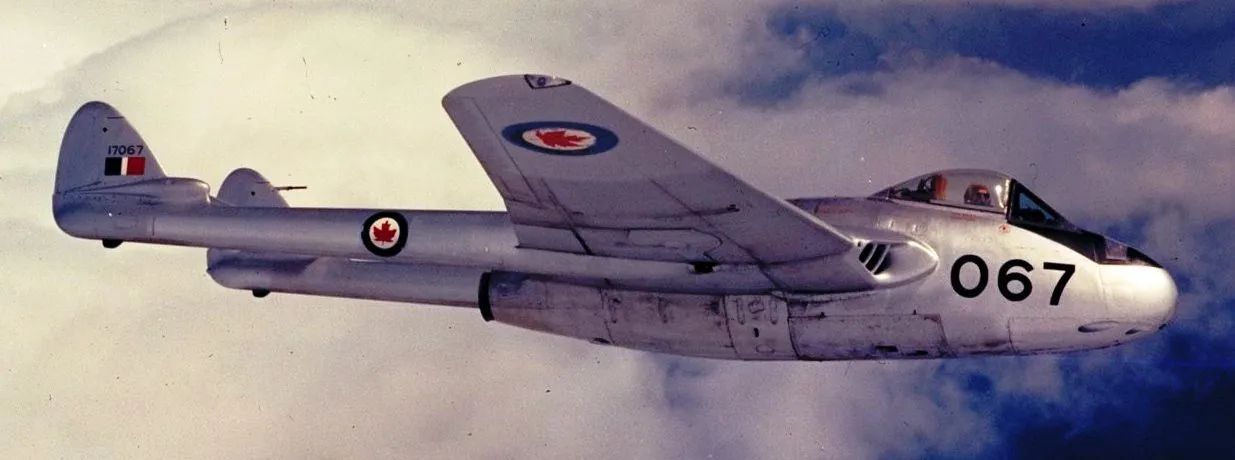
de Havilland DH.100 Vampire, RCAF (Serial No. 17067), No. 411 "County of York" Squadron (Auxiliary), Toronto, Ontario
The de Havilland Vampire is a British jet fighter which was developed and manufactured by the de Havilland Aircraft Company. It was the second jet fighter to be operated by the RAF, after the Gloster Meteor, and the first to be powered by a single jet engine.
Development of the Vampire as an experimental aircraft began in 1941 during the Second World War, to exploit the revolutionary innovation of jet propulsion. From the company's design studies, it was decided to use a single-engine, twin-boom aircraft, powered by the Halford H.1 turbojet (later produced as the "Goblin"). Aside from its propulsion system and twin-boom configuration, it was a relatively conventional aircraft. In May 1944 it was decided to produce the aircraft as an interceptor for the Royal Air Force (RAF). In 1946 the Vampire entered operational service with the RAF, only months after the war had ended.
The Vampire quickly proved to be effective and was adopted as a replacement of wartime piston-engined fighter aircraft. During its early service it accomplished several aviation firsts and achieved various records, such as being the first jet aircraft to cross the Atlantic Ocean. The Vampire remained in front-line RAF service until 1953 when it was progressively reassigned to various secondary roles, such as ground attack and pilot training, for which specialist variants were produced. The RAF retired the Vampire in 1966 when its final role of advanced trainer was filled by the Folland Gnat. The Royal Navy had also adapted the type as the Sea Vampire, a navalised variant suitable for operations from aircraft carriers. It was the service's first jet fighter.
The Vampire was exported to a wide variety of nations and was operated worldwide in numerous theatres and climates. Several countries deployed the type in combat during conflicts, including the Suez Crisis, the Malayan Emergency, and the Rhodesian Bush War. By the end of production, almost 3,300 Vampires had been manufactured, a quarter of these having been manufactured under licence in several other countries.
The layout of the DH.100 used a single jet engine installed in an egg-shaped fuselage which was primarily composed of plywood for the forward section and aluminium throughout the aft section. It was furnished with conventional mid-mounted straight wings; air brakes were installed on the wings to slow the aircraft, a feature that had also been incorporated in the Meteor. Armament comprised four 20 mm Hispano Mk V cannon located underneath the nose; from the onset of the design phase, even when the aircraft was officially intended to serve only as an experimental aircraft, the provision for the cannon armament had been included.
In 1946, a single Vampire F.1 began operating on an evaluation basis in Canada at the Winter Experimental Establishment in Edmonton. The Vampire F.3 was selected as one of two types of operational fighters for the Royal Canadian Air Force (RCAF) and was first flown in Canada on 17 January 1948 where it went into service as a Central Flying School training aircraft at RCAF Station Trenton. Operating a total of 86 aircraft, the Vampire F.3 became the first jet fighter to enter RCAF service in any significant numbers.
The Vampire had the function of introducing Canadian fighter pilots not only to jet propulsion, but also to other amenities such as cockpit pressurisation and the tricycle landing gear arrangement. It proved to be a popular aircraft, being easy to fly and often considered a "hot rod". In Canadian service, the Vampire served in both operational and air reserve units (400, 401, 402, 411, 438 and 442 squadrons). During the late 1950s, the type was retired and was replaced in RCAF service by the Canadair Sabre.Wikipedia
After retirement, 26 of the surplus RCAF Vampires were sold to the Formetal Division of Fliteways Inc., West Bend, Wisconsin, USA in 1958. Another 4 airframes were to provide spares. Aerial Blight Control, also of West Bend, refurbished 15 Vampires for sale to the Mexican Air Force starting in 1959. The FAM operated the Vampires until about 1970. Several of the remaining Vampires purchased by Fliteways found their way to the US civil market. Some may now be found in museums in Mexico, the U.S. or Canada.
 Wikipedia de Havilland Vampire
Wikipedia de Havilland Vampire
 de Havilland Vampire - Kestrel Publications
de Havilland Vampire - Kestrel Publications
410 Sqn Noctivaga ("Cougar")
History of the Squadron during World War II (Aircraft: Defiant IF, Beaufighter IIF, Mosquito NF II, FB VI, NF XIII,)
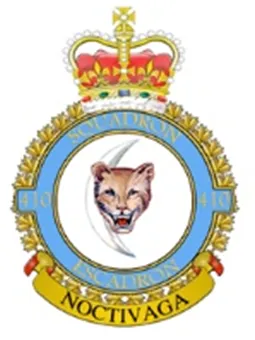
The Squadron was formed at Ayr, Scotland on June 30, 1941 as the RCAF's third Night Fighter squadron to be formed overseas in WWII. It was the ninth RCAF squadron formed overseas. The squadron flew Boulton Paul Defiant, Bristol Beaufighter and later de Havilland Mosquito aircraft in the night air defence of Britain, and then Europe. It was based at a number of locations in the UK before moving to Europe in September 1944, where it remained until the end of hostilities. It was disbanded at Gilze-Rijen, the Netherlands , on June 9, 1945.
In the course of the conflict, the squadron flew 2972 sorties and accounted for 75 enemy aircraft confirmed destroyed, with 2 probables and 9 damaged. Operational casualties were 17 aircraft and 32 aircrew, of whom 10 were killed, 20 presumed killed and 2 POW. The squadron had 10 aces (shot down 5 or more enemy aircraft), of whom 4 were pilots and the others navigators: kills were credited to both crew members (Flight Lieutenant R.D. Schultz DFC&Bar; Flying Officer D.G. Tonque, RAF DFC&Bar (Nav.); Lieutenant A.A. Harrington (USAAF) DSO,DFC; Flight Lieutenant C.E. Edinger DFC; Flying Officer J.S. Christie (RAF) DFC (Nav.); Flying Officer C.L. Vaessen DFC (Nav.); Flight Lieutenant G.P.A. Bodard DFC (Nav.); Squadron Leader J.D. Somerville DSO, DFC; Flying Officer G.D. Robinson DFC (Nav.); Flight Lieutenant V.A. Williams DFC (Nav.). The squadron won 1 DSO, 1 MBE, 2 Bars to DFC, 19 DFCs, 1 BEM and 17 Mentioned in Dispatches. Battle Honours were: Defence of Great Britain 1941-44, Fortress Europe 1943, France and Germany 1944-45 Normandy 1944, Rhine, Biscay 1943.Wikipedia, Kostenuk and Griffin
Maps for Movements of 410 Squadron 1941-45
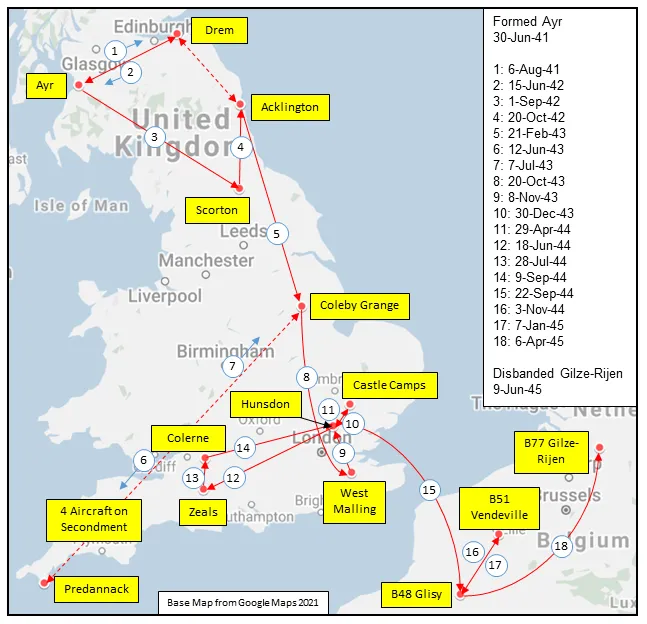
410 Squadron History Summary 1941-45
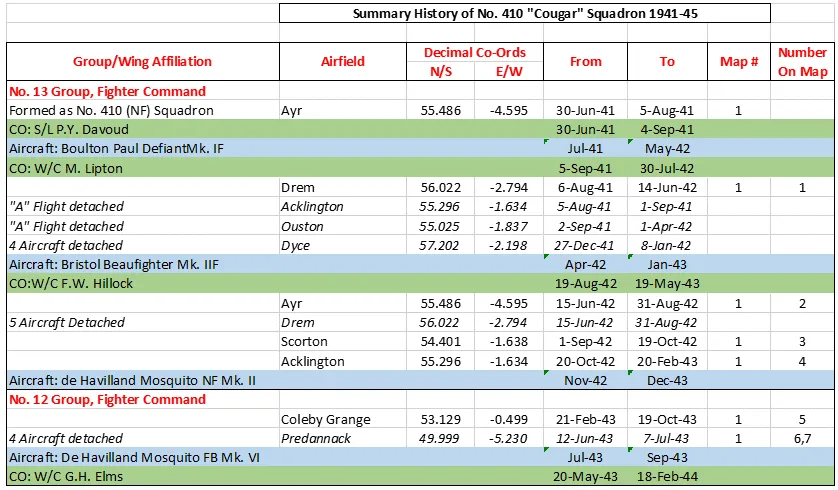
410 Squadron History Summary 1941-45 Page 2
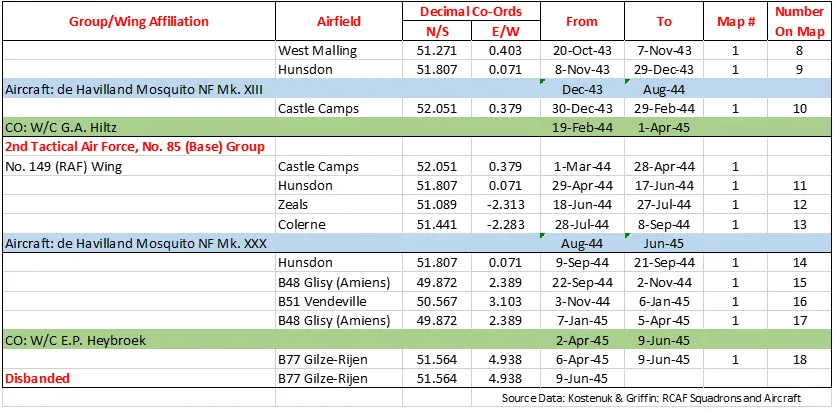
History of the Squadron Post-WWII (Aircraft: Vampire III, Sabre 2, CF-100, Voodoo, Hornet)
The squadron was re-formed in a Fighter role at St Hubert (Montreal), Quebec on 1 December 1948. It was the first post-war Regular Force fighter unit, the first to fly Vampire and Sabre aircraft, and the first to join No. 1 (Fighter) Wing of No. 1 Air Division Europe. In 1956, it was decided to replace one Sabre squadron in each of the Air Division’s four wings with an all-weather fighter unit. When No. 445 AW(F) Squadron arrived from Canada, No. 410 was deactivated at Marville, France on 1 October 1956 and reactivated as All-Weather (Fighter) at Uplands (Ottawa), Ontario on 1 November. The squadron flew CF-100 and CF-101 aircraft on North American air defence until being disbanded on 1 April 1964.
In 1968, No.3 (Operating Training Unit) at CFB Bagotville, Quebec , which was tasked with training pilots and navigators for the three operational RCAF Voodoo squadrons, was renamed No. 410 Squadron. It moved to Cold Lake, Alberta in 1982, changing aircraft to become the training unit for Canada's new CF-18 Hornet aircraft. The squadron’s mission is: To Train World Class Fighter Pilots to Meet Canada's Needs.
The squadron runs two ab initio Fighter Pilot Courses (FPC) each year, training up to 20 fighter pilots. Each course comprises seven intense months of academics, simulator flights and flying missions. Graduates are taken from 419 Tactical Fighter (Training) Squadron (also known as NATO Flying Training in Canada (NFTC) Phase IV) and then provided with the tools to develop a solid foundation in both air-to-air and air-to-ground fighter combat.The squadron is also responsible for training and recertifying approximately five former CF-18 Hornet pilots annually. These are pilots who are returning to the CF-18 cockpit after a ground or exchange tour. Furthermore, 410 Squadron also trains newly arrived foreign exchange officers who will be joining one of Canada's two operational fighter squadrons.
A lesser-known sub-unit of 410 Squadron is FOTEF. FOTEF - the Fighter Operational Test & Evaluation Flight - is responsible for the operational testing and evaluation to meet the needs of the Fighter Force (FF). Their efforts have been and continue to be integral to the operational effectiveness of all aspects of core and CF-18 capabilities. Some the new systems being evaluated are Night Vision Imaging Systems (NVIS), Multi-function Information Distribution Systems (MIDS), the Advanced Multi-role Infra-Red Sensor, the evaluation of new mission planning software and the Advanced Distributed Combat Training System (the civilian contracted simulator system). Working closely with a variety of key units across the Air Force including the Aerospace Engineering & Test Establishment (AETE), FOTEF has enabled the seamless integration of newly modernized CF-18 ECP-583 R2 aircraft into the FF.
 Canadian Virtual War Memorial
Canadian Virtual War Memorial Harold A Skaarup Web Page
Harold A Skaarup Web Page YouTube de Havilland Vampire
YouTube de Havilland Vampire